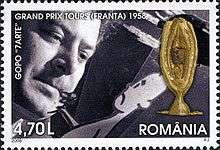Ion Popescu-Gopo
| Ion Popescu-Gopo | |
|---|---|
 | |
| Born |
1 May 1923 Bucharest, Romania |
| Died |
29 November 1989 (aged 66) Roești, Vâlcea |
| Occupation | Graphic artist and animator |
Ion Popescu-Gopo (Romanian pronunciation: [iˈon poˈpesku ˈɡopo]; 1 May 1923, Roești, Vâlcea – 28 November 1989, Bucharest) was a Romanian graphic artist and animator, but also writer, movie director and actor born in Bucharest, Romania. He was a prominent personality in the Romanian cinematography and the founder of the modern Romanian cartoon school. He was, together with Liviu Ciulei and Mirel Ilieşiu one of the few Romanian film artists who won an award at Cannes in the 20th century. His film "Scurtă Istorie" (A Brief History) won the Short Film Palme d'Or for best short film in 1957. His 1965 film The White Moor was entered into the 4th Moscow International Film Festival where he won the award for Best Director.[1] In 1969 he was a member of the jury at the 6th Moscow International Film Festival.[2] In 1977 he was a member of the jury at the 10th Moscow International Film Festival.[3] In 1983 he was a member of the jury at the 13th Moscow International Film Festival.[4]
Ion Popescu-Gopo attended (but never graduated from) the Academy of Fine Arts in Bucharest. He also attended animation courses in Moscow. He made Maria, Mirabela which is a Romanian-Russian co-production.
His career started as a designer and cartoonist in 1939, publishing caricatures and editorial cartoons in newspapers. 1949 brought his debut in the film industry with "Punguţa cu doi bani" (Bag with two coins). Since 1950 he started working for Studioul Cinematografic Bucureşti (Cinematographic Studio Bucharest) in the animation department, that later broke into a separate animation studio, Animafilm.
His most known cartoon character is a little black and white man sometimes referred to as "Gopo's Little Man" after his creator. Later in his life Popescu-Gopo confessed that he tried to start an "anti-Disney rebellion". Unable to surpass Disney's animation characters in color and beauty, Popescu-Gopo tried to be more profound in message and substance and simplify the form and techniques used. Unlike Disney's cartoon characters, Popescu-Gopo's cartoon characters were black and white, designed in simple lines.
References
- ↑ "4th Moscow International Film Festival (1965)". MIFF. Retrieved 2012-12-03.
- ↑ "6th Moscow International Film Festival (1969)". MIFF. Retrieved 2012-12-17.
- ↑ "10th Moscow International Film Festival (1977)". MIFF. Retrieved 2013-01-07.
- ↑ "13th Moscow International Film Festival (1983)". MIFF. Retrieved 2013-01-28.
External links
- http://www.festival-cannes.fr/archives/prix.php?langue=6002&edition=1957&x=7&y=1#cm
- http://www.imdb.com/Sections/Awards/Cannes_Film_Festival/1957
- http://www.imdb.com/name/nm0691255/
- http://agenda.liternet.ro/ionpopescugopo.php